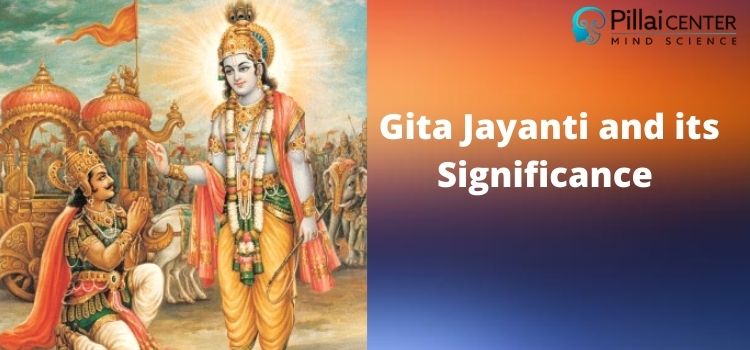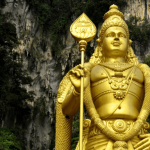Gita Jayanti
Gita Jayanti is a popular Hindu festival. The festival celebrates the arrival of the sacred Hindu scripture, Bhagavad Gita from Shri Krishna, an avatar of Maha Vishnu. Gita Jayanti was the day when Krishna preached Gita to Arjuna, one of the five Pandavas.
Every year, the Shukla Ekadashi falling on the Margashirsha month of the Hindu calendar is observed as Gita Jayanti. On this day, people perform special worship to the Bhagavad Gita, and they read the shlokas from Gita.
Bhagavad Gita
Bhagavad Gita is an important and popular scripture of Hinduism. It is a part of Mahabharatha, one of the two great epics of India. The word ‘Bhagavad Gita’ consists of two Sanskrit terms, ‘Bhagavad’ means ‘God’ or ‘Divine’ and Gita refers to ‘Song.’ Thus, Bhagavad Gita means, ‘Song of the Divine.’
Gita Jayanti is an important day for Hindus. On this day, the holy book of Hindus, Bhagavad Gita, was born, i.e., Gita Jayanti is the day on which Lord Shri Krishna told the Gita to Arjuna. Researches have proved that Mahabharata happened 5000+ years before, so Bhagavad Gita is old by at least 5000 years.
Krishna revealed the ‘Bhagavad Gita’ to Arjuna at the battlefield of the ancient city of Kurukshetra. Research has established that Kurukshetra is in the present Indian state of Haryana. It is among the holy cities of Hindus and is visited by Hindu pilgrims throughout the year.
Bhagavad Gita’s original text in Sanskrit. It consists of 18 chapters and 700+ shlokas. The following are its chapter names.
- Chapter 1: Arjuna Visada Yoga (The Yoga of Arjuna’s Dejection)
- Chapter 2: Sankhya Yoga (The Yoga of Analysis)
- Chapter 3: Karma Yoga (The Yoga of Action)
- Chapter 4: Gnana Yoga (The Yoga of Knowledge)
- Chapter 5: Sanyasa Yoga (The Yoga of Renunciation
- Chapter 6: Dhyana Yoga (The Yoga of Meditation)
- Chapter 7: Vigyana Yoga (The Yoga of Wisdom)
- Chapter 8: Taraka Brahma Yoga (The Yoga of Liberating Spirit)
- Chapter 9: Raja Vidhya Raja Guhya Yoga (The Yoga of Royal and Hidden Knowledge)
- Chapter 10: Vibhuti Yoga (The Yoga of Excellence)
- Chapter 11: Viswaroopa Darshana Yoga (The Yoga of Seeing the Cosmic Form)
- Chapter 12: Bhakti Yoga (The Yoga of Devotion)
- Chapter 13: Prakruti Purusha Viveka Yoga (The Yoga of Distinguishing Matter from Spirit)
- Chapter 14: Gunatraya Vibhaga Yoga (The Yoga of the Threefold Modalities)
- Chapter 15: Purushottama Yoga (The Yoga of the Ultimate Person)
- Chapter 16: Daivasurua Yoga (The Yoga of Differentiating Godly and Ungodly Assets)
- Chapter 17: Shraddha Traya Vibhaga Yoga (The Yoga of Differentiating Threefold Faith)
- Chapter 18: Moksha Yoga (The Yoga of Liberation)
The Legend of Bhagavad Gita
Srimad Bhagavad Gita came into being just before the commencement of the great war of Kurukshetra.
After all the conciliatory efforts to avert war between the Kauravas and Pandavas did not fructify, both sides agreed to proceed with the war. On the first day of the war, armies of both sides assembled at Kurukshetra, the battleground.
Before the first-day battle was about to commence, Arjuna asked Lord Krishna, his charioteer, to drive the chariot to the middle of the battlefield. When Krishna took Arjuna to the middle of the battleground, he looked at the army of both sides and saw his gurus, cousins, friends, and relatives on the opposite side and thinking that he had to fight with them, he was overcome with emotion.
Arjuna lost his composure, became anxious, and started trembling. Forgetting his duties as a Kshatriya, he dropped his bow and arrow and fell on his seat in despair. Arjuna confessed to Krishna that he could not participate in the battle because he lost his fighting spirit. Arjuna prayed to Krishna and sought his counsel as he considered Krishna his best friend, guide, well-wisher, and philosopher.
Krisha being the avatar of Vishna, revealed his true form to Arjuna and taught him divine knowledge. So Arjuna was lucky enough to witness Krishna’s Vishwaroopa darshan and got to know the secrets of creation and the mystery of life.
How is Gita Jayanti celebrated?
On Gita Jayanti, devotees read the Bhagavad Gita and participate in discussions and seminars on Gita conducted by eminent scholars. The pandits and scholars well versed in Gita explain its significance and message.
At Kurukshetra, events related to Gita are organized in the Vishnu and Krishna temples. Special pujas are conducted on Gita Jayanti. Many Hindu devotees and pilgrims arrive at Kurukshetra and undertake a sacred bath in the holy ponds, Sannihit Sarovar and Brahm Sarovar.
A special fair is organized, and the people participate in Gita recitals and bhajans. In addition, programs like special aarti, dance, dramas, etc., also take place.
Significance of Gita
Apart from being an ancient religious scripture, the Bhagavad Gita is also a life guide. It helps a person know his strengths, understand his weakness, and learn how to face a challenging situation. Several researchers across the World have recognized the depth of Bhagavad Gita as a life guide. Many sportspersons, social workers, politicians, business leaders, film stars, etc., have acknowledged the impact of Gita in their life.
Great Indian personalities like Vivekananda, Lokmanya Tilak, Mahatma Gandhi, Netaji Subhash Bose, Aurobindo were influenced by the thoughts expressed in the Bhagavad Gita.
Gita impresses upon an individual to do a self-inquiry and perform the duty diligently without expecting results. Its translation is available in several languages of the World, and continuous research is going on to know more about its message.
2021 Gita Jayanti
As per the traditional Hindu calendar, every year, Gita Jayanti falls on the 11th day of the Shukla Paksha (waxing phase of moon) of the Margashirsh month. This year the festival is occurring on Tuesday, December 14, 2021.
« How to Worship Kala Bhairava Arudra Darisanam 2021: Significance of Arudra Darshan »


